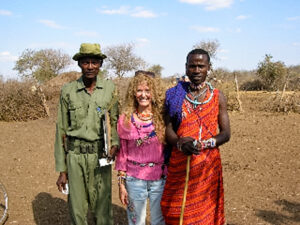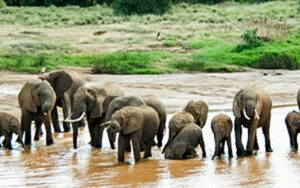The Plight of Elephants
The Plight of Elephants
In Africa, some tribes have a wonderful way to greet each other like this..
- “How are you?”
- “I am well if you are well.”
- “I am well.”
- ”Good, then we are both well.”
If the person responds with “I am not well”, the other takes on the pain of their friend. It’s a beautiful expression of genuine family and community care for each other.
I would say that I am well if the elephants are well, but they are not.
This is what I discovered in my years in Africa…
The threats to elephants in the wild are the following:
- Poaching, hunting and The Ivory Trade
- Legal slaughter (euphemistically called culling)
- Loss of habitat (due to over population of humans)
- Drought and global warming
- Domestication
Poaching, Hunting and the Ivory Trade
In the 1980’s, an estimated 100,000 elephants were killed each year. Prior to the ban on ivory trade which took place in December of 1989, (thanks to the hard work of people like Dr. Iain Douglas-Hamilton and Richard Leakey), the elephant population had plummeted from about 3 million, Africa-wide, to only 240,000! Kenya alone lost 85% of its elephant population. But after the ban, little by little, the population of elephants started to increase.
Poaching is on the rise and hunting of elephants is allowed in many places, especially Southern Africa. Now one can go to Khartoum, the capital of Sudan and find (according to the late Dr. Esmond Bradley-Martin), in open display, 12,000 pieces of ivory being sold in 50 shops. That represents the death of thousands of elephants. 75% of the poached ivory is being bought by China and is supplied mostly by the Congo, Chad and some from Kenya. In elephant society, knowledge and wisdom of where to find water during a drought, where food and safe places are and how to dig for water, are passed down from the oldest and wisest matriarch. When they are poached for their ivory, that knowledge is lost and the herd then becomes weak, vulnerable, and confused. Of course, if the matriarch had any babies, they will die without her milk. So when one elder elephant is killed for her ivory, it represents the death of many more.
Orphaned elephant rescued by the team at the Sheldrick Wildlife Trust in Kenya
People poach elephants mostly for greed. But famine and war contribute to it also. If people are hungry, they will kill an elephant for food. If tribes are at war, they will kill an elephant for its ivory to pay for weapons. Preserving elephants requires stable economies, prosperity and peace among tribes and nations. These issues must also be addressed and solved if elephants are to survive.
Hunting, as a sport, is different. It is done mostly by depraved wealthy people for fun and machismo.
Pachyderm Power’s Own Anti-Poaching Patrol!!
 The man on my right, in uniform, was the very first Maasai employee of Pachyderm Power’s new Anti-Poaching Patrol!!!!! We were so thrilled to be starting this project. Maasai should be at the forefront of wildlife conservation because they live in the bush with wild animals and have deep knowledge about them! Community-based patrols can help safeguard elephants and habitats for generations.
The man on my right, in uniform, was the very first Maasai employee of Pachyderm Power’s new Anti-Poaching Patrol!!!!! We were so thrilled to be starting this project. Maasai should be at the forefront of wildlife conservation because they live in the bush with wild animals and have deep knowledge about them! Community-based patrols can help safeguard elephants and habitats for generations.
Legal Slaughter (euphemistically called “Culling”)
The southern African countries (South Africa, Zimbabwe, Namibia, Botswana) claim they have too many elephants and so they solve the problem by killing them. When they kill elephants, they kill the whole family because they have discovered, over the years, that if they don’t kill all the members of an elephant family, those left, who are terribly traumatized, communicate over long distances through the use of infra sound, to other herds about the massacre. And elephants never forget.
An elephant conservationist from Kenya was taken up in a small plane to fly over the elephants in Kruger Park of South Africa where they slaughter their elephants. Much to his surprise the elephants fled in a panic at the sound and sight of the plane. He had never seen this happen in Kenya. He asked his South African host about this, who thought it was normal! The elephants remember culling and were responding to the plane with fear! One time during a slaughtering of a herd, a mother elephant was shot but not quite dead. The man doing the evil deed was lifting his rifle up to shoot the elephant’s baby. The dying elephant lifted her trunk and put it on the man’s arm to pull it away from the rifle to keep him from killing her baby. Amazing mother love. Yes, they feel just like we do. They love just like we do. They fear death just like we do.
When a whole family is killed its genetic variability is lost forever. Fact is, there are other ways for dealing with the so-called over population of elephants besides slaughtering them. One is to open up corridors into other countries where the elephants can roam. This is being done. Another is through the use of contraception. I worked with a conservationist by the name of Dr. Audrey Delsink, who has successfully stopped the overpopulation of elephants in a private reserve in South Africa through the use of a simple vaccine that is a contraception. But South African officials and many South Africans do not want to use it. They ask: “What’s in it for us?”. The legal slaughter of the elephants in South Africa provides food, skin and ivory. And that is what they really want. They even have elephant slaughter houses.
Loss of Habitat Due to Overpopulation
 This is pandemic. Yet humans continue to multiply with little awareness of the devastation such huge numbers are causing the environment, the earth, all wildlife, and especially elephants.
Elephants require huge space to roam. A bull elephant can easily travel over 50 miles in a day. They do so in search of food, water or just to visit some old friends. The human need for housing and farmland means that the habitat elephants need is constantly and exponentially being lost.
This is pandemic. Yet humans continue to multiply with little awareness of the devastation such huge numbers are causing the environment, the earth, all wildlife, and especially elephants.
Elephants require huge space to roam. A bull elephant can easily travel over 50 miles in a day. They do so in search of food, water or just to visit some old friends. The human need for housing and farmland means that the habitat elephants need is constantly and exponentially being lost.
Drought and Global Warming
If there is no water due to drought and global warming, vegetation can not grow to feed hungry elephants who eat about 500 pounds of food per day and need about 50 gallons of water. As the earth dries up, elephants starve.
Now, with the increase of climate caused catastrophes, droughts in Africa are driving elephants to extinction. The pregnant elephants are having miscarriages and more elephants are dying than are being born. My focus now is to build water sources in the areas where elephants are dying from lack of water. If interested, please join my efforts to stop the impending extinction of the world’s walking splendor: The majestic Elephant.
Domestication
It has not been the tradition in Africa to domesticate their wild elephants. But greed motivates some tour companies to do so. For example, in 2006, Shearwater Adventures kidnapped 12 young wild elephants from the Hwange National Park in Zimbabwe to domesticate them for profit. Training methods are horrible. Elephant specialist, Dr. Joyce Poole, of ElephantVoices, submitted an affidavit regarding the cruelty involved in capturing and training wild elephants. She wrote the Attorney General requesting a ban on future capture of wild elephants.
When I was working in Thailand at an elephant sanctuary, I talked to Thai elephant conservationist, Lek Chailert, about what training method Africans might be using. She told me she knew exactly what they were using, namely The Crushing Box, because mahouts (Asian people who own elephants) from Thailand and Sri Lanka had been hired to teach the Africans that method. Further, she had told the Africans that they could train the elephants using love and kindness but they weren’t interested in it because “it took too long”.
From Jennifer Hile in National Geographic Today, October 18, 2002: ”It’s a sound not easily forgotten. Just before dawn in the remote highlands of northern Thailand…a four year old elephant bellows as seven village men stab nails into her ears and feet. She is tied up and immobilized in a small, wooden cage…The cage is called a “training crush”. It’s the centerpiece of a centuries old ritual in Thailand designed to domesticate young elephants. In addition to beatings, handlers use sleep-deprivation, hunger and thirst to “break” the elephant’s spirit and make them submissive to their owners.”
The Zimbabwe Conservation Task Force, founded by the late Johnny Rodrigues, said this about the new trend in parts of Africa to kidnap and domesticate wild elephants:
“According to a statement written by scientists from the Amboseli Elephant Research Project in Kenya, the breaking up of elephant families by removing their young creates a very high level of stress, not only for the captured elephants, but also for the family members left behind. The researchers have witnessed elephant captures where the screams of the captured elephants cause their family members to attempt to rescue them. Both the elephants caught and those left behind were found to suffer physical trauma, dehydration, immune system suppression and long term psychological trauma. They claim that due to the excellent memories of elephants, they are likely to respond aggressively towards humans, vehicles and helicopters in the future”.
The following paragraph was taken from their statement:
“Elephants are renowned for their memories, intelligence and sociability. Similar to those of humans, these traits also make them particularly vulnerable to stress and trauma and their long term consequences. These effects would be long lasting both for the animals removed from their families and for those remaining in the reserve. Our strong recommendation is that the authorities order, with all urgency, an immediate moratorium on the capture and training of young elephants, and prohibit all removals of this nature in the future”.
The attempted domestication of wild elephants is not only unspeakably cruel but it is also very dangerous to unsuspecting tourists. An elephant that has been trained will most likely have been subjected to cruelty and abuse. In order to make the elephant obedient the usual method is to break its spirit. This breeds resentment and, in time, some elephants have been known to turn on humans.
Visit our Youtube channel!
